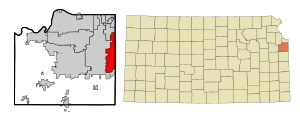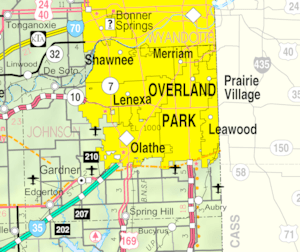Leawood, Kansas facts for kids
Quick facts for kids
Leawood, Kansas
|
|
|---|---|

Location within Johnson County and Kansas
|
|

|
|
| Country | United States |
| State | Kansas |
| County | Johnson |
| Founded | 1920s |
| Incorporated | 1948 |
| Named for | Oscar Lee |
| Area | |
| • Total | 15.21 sq mi (39.38 km2) |
| • Land | 15.11 sq mi (39.12 km2) |
| • Water | 0.10 sq mi (0.26 km2) |
| Elevation | 958 ft (292 m) |
| Population
(2020)
|
|
| • Total | 33,902 |
| • Density | 2,228.9/sq mi (860.89/km2) |
| Time zone | UTC-6 (CST) |
| • Summer (DST) | UTC-5 (CDT) |
| ZIP code |
66206, 66207, 66209, 66211, 66224
|
| Area code | 913 |
| FIPS code | 20-39075 |
| GNIS ID | 485611 |
Leawood (pronounced LEE-wood) is a city in Johnson County, Kansas, in the United States. It is part of the larger Kansas City metropolitan area. In 2020, about 33,902 people lived in Leawood.
Contents
History of Leawood
Early Beginnings in the 1800s
After the Louisiana Purchase in 1803, the land where Leawood now stands became open for new settlers. The famous Santa Fe Trail, a busy trade route, also passed through this area. This helped the region grow.
However, the area faced tough times during the "Border Ruffian War" (1855-1857). This was part of a bigger conflict called Bleeding Kansas. People who supported slavery from Missouri attacked settlers and traders. This made the local economy suffer.
Things got better with the founding of Oxford, Kansas, which was an early version of Leawood. But the American Civil War (1861-1865) caused a lot of damage. By 1865, not much was left of the township.
Leawood was named after Oscar G. Lee. He was the first person to own the land where the town was built.
Leawood in the 1900s: A City Grows
Modern Leawood started in the 1920s. This was when Oscar G. Lee, a retired police chief from Oklahoma, moved to Johnson County. He helped build Lee Boulevard, a road for everyone to use.
In 1948, a company called Kroh Brothers started building homes here. This led to Leawood officially becoming a city. On November 30, 1948, Leawood was recognized as a "city of the third class." It had less than 2,000 people then.
By 1959, Leawood had grown to a "city of the second class." As of 2014, it is a "city of the first class," with about 32,800 residents.
By 2015, Leawood was known as one of the wealthiest suburbs in the Kansas City area. Some neighborhoods, like Hallbrook and Tuscany Reserve, were ranked among the top 1% for wealth.
Early Rules for Homeowners
The Kroh Brothers, who developed Leawood, used rules for homeowners. These rules were similar to those used by another city planner, J. C. Nichols. These rules often included things like large lots, curved streets, and similar house styles.
For many years, these rules also included unfair restrictions. For example, some early rules prevented certain groups of people from buying or living in homes. These types of rules are now illegal and are seen as a sad part of history.
The Kroh Brothers also built shopping malls and office buildings. Their projects spread across many states.
Geography of Leawood
Leawood covers about 15.16 square miles (39.26 square kilometers). Most of this area is land, with a small amount of water.
The city is surrounded by other cities. On three sides, it borders Overland Park and Prairie Village in Kansas. On the fourth side, it borders Kansas City, Missouri. About 75% of Leawood's land is already developed. The city expects to continue growing in the future.
People and Community in Leawood
| Historical population | |||
|---|---|---|---|
| Census | Pop. | %± | |
| 1950 | 1,167 | — | |
| 1960 | 7,466 | 539.8% | |
| 1970 | 10,349 | 38.6% | |
| 1980 | 13,360 | 29.1% | |
| 1990 | 19,693 | 47.4% | |
| 2000 | 27,656 | 40.4% | |
| 2010 | 31,867 | 15.2% | |
| 2020 | 33,902 | 6.4% | |
| U.S. Decennial Census 2010-2020 |
|||
Population in 2020
The 2020 United States census counted 33,902 people living in Leawood. There were 12,742 households and 9,974 families. The city has a mix of different backgrounds. About 86.5% of the people were White, 1.5% Black, 5.1% Asian, and 6.1% were from two or more races. About 3.2% of the population was Hispanic or Latino.
Many households (33.2%) had children under 18. Most households (70.9%) were married couples living together. The average household had 2.6 people. The average family had 3.0 people. About 57.9% of the people had a college degree or higher.
The median age in Leawood was 46.5 years. About 24% of the population was under 18. About 22.4% were 65 years or older.
Leawood is known for having a high median household income. This means that families in Leawood generally earn more money than in many other places.
Religion in Leawood
Leawood is home to the main campus of the United Methodist Church of the Resurrection. This is the largest church in the Kansas City Metropolitan Area. It is also the largest Methodist church in the country. It has 22,000 members.
In 2017, a very large stained glass artwork was added to the church. It shows stories of Jesus and Martin Luther King Jr. Leawood also has three Catholic churches: Church of the Nativity, Curé of Ars, and St. Michael the Archangel.
Economy and Shopping
Top Employers in Leawood
Here are some of the biggest employers in Leawood, based on a 2017 report:
| # | Employer | # of Employees |
|---|---|---|
| 1 | AMC Theatres Support Center | 450 |
| 2 | Reece & Nichols | 415 |
| 3 | American Academy of Family Physicians | 362 |
| 4 | Blue Valley Unified School District | 346 |
| 5 | Select Quote | Less Than 50 (2024 Layoffs) |
| 6 | City of Leawood | 256 |
| 7 | Murphy-Hoffman Company | 250 |
| 8 | Nueterra Holdings Company | 184 |
| 9 | DEMDACO | 150 |
| 10 | Bukaty Companies | 120 |
Shopping Centers
Town Center Plaza is a popular shopping spot in Leawood. It has many upscale stores. Some of these stores are unique to the Kansas City area.
Education in Leawood
Schools Serving Leawood
Two public school districts serve the students in Leawood. They are the Shawnee Mission School District and the Blue Valley USD 229.
Libraries for the Community
The Johnson County Library system provides library services to the people of Leawood.
In 2014, there was a discussion about "Little Free Libraries" in Leawood. These are small boxes where people can share books for free. City rules at the time did not allow these structures in front yards. A 9-year-old boy who built one started a Facebook page to support changing the rule. Residents are now working with the city to update the rules.
Famous People from Leawood
Many notable people have lived in or were born in Leawood. These include:
- Heidi Gardner, a comedian from Saturday Night Live
- Min Kao, who helped start Garmin Corporation
- Julie Garwood, a romance novelist
- Karen McCarthy, a former U.S. Representative from Missouri
- Dan Quisenberry, a baseball pitcher
- Joyce Clyde Hall, who founded Hallmark Cards
- Travis Kelce, a tight end for the Kansas City Chiefs football team
Sister Cities
Leawood has special connections with two other cities around the world:
See also
 In Spanish: Leawood (Kansas) para niños
In Spanish: Leawood (Kansas) para niños

